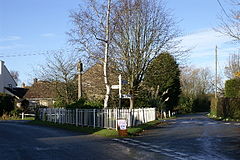Kingston Seymour
| Kingston Seymour | |
|---|---|
 The Triangle |
|
| Kingston Seymour shown within Somerset | |
| Population | 388 (2011) |
| OS grid reference | ST402670 |
| Unitary authority | |
| Ceremonial county | |
| Region | |
| Country | England |
| Sovereign state | United Kingdom |
| Post town | CLEVEDON |
| Postcode district | BS21 |
| Dialling code | 01934 |
| Police | Avon and Somerset |
| Fire | Avon |
| Ambulance | South Western |
| EU Parliament | South West England |
| UK Parliament | |
Kingston Seymour is a small village and civil parish in Somerset, England. It is situated within the unitary authority of North Somerset, between Clevedon and Weston-super-Mare on the North Somerset Levels. The parish has a population of 338. The M5 motorway passes very close to the village.
The late medieval village cross stands on "The Triangle".
The parish was part of the hundred of Chewton.
The village suffered serious flooding in the Bristol Channel floods of 1607 when the sea walls were breached and the church in Kingston Seymour was said to have 5 feet (2 m) of water in it for ten days. The parish, which extends to the Severn Estuary coast, saw flooding on a regular basis as late as the 1800s. After flooding, the land was considered unsuitable for dairy cattle for some time and the resulting bad air was said to cause "attacks of the ague" in local people.
Kingston Seymour school opened its doors in 1858. Closing in 1968, the building was then used as an office for the local drainage board and later as a spinning and weaving centre. It has now been converted into a private house.
The village used to be on the route of the Clevedon branch line a 3.5 miles (5.6 km) railway line that ran from Yatton railway station to Clevedon. It was opened in 1847 and passenger services ceased in 1966. The last original bits of track, around Kingston Seymour, were lifted in the late 1980s.
The parish council has responsibility for local issues, including setting an annual precept (local rate) to cover the council’s operating costs and producing annual accounts for public scrutiny. The parish council evaluates local planning applications and works with the local police, district council officers, and neighbourhood watch groups on matters of crime, security, and traffic. The parish council's role also includes initiating projects for the maintenance and repair of parish facilities, such as the village hall or community centre, playing fields and playgrounds, as well as consulting with the district council on the maintenance, repair, and improvement of highways, drainage, footpaths, public transport, and street cleaning. Conservation matters (including trees and listed buildings) and environmental issues are also of interest to the council.
...
Wikipedia

